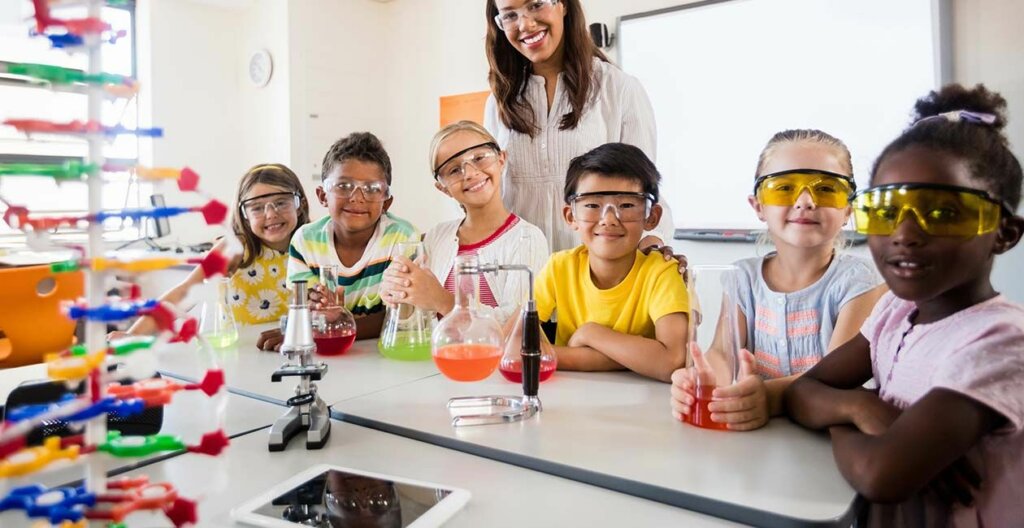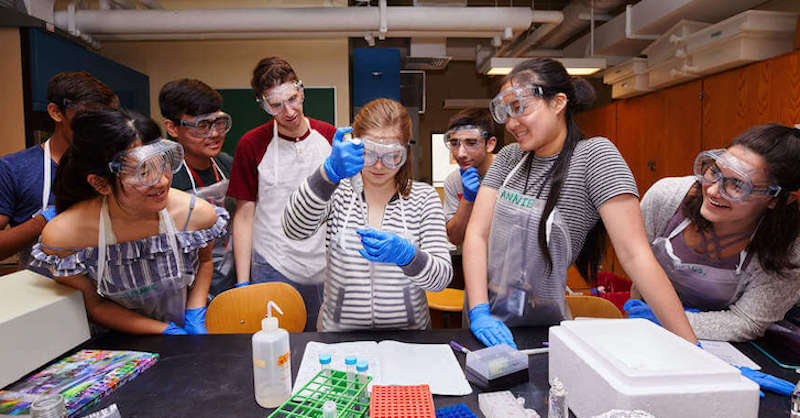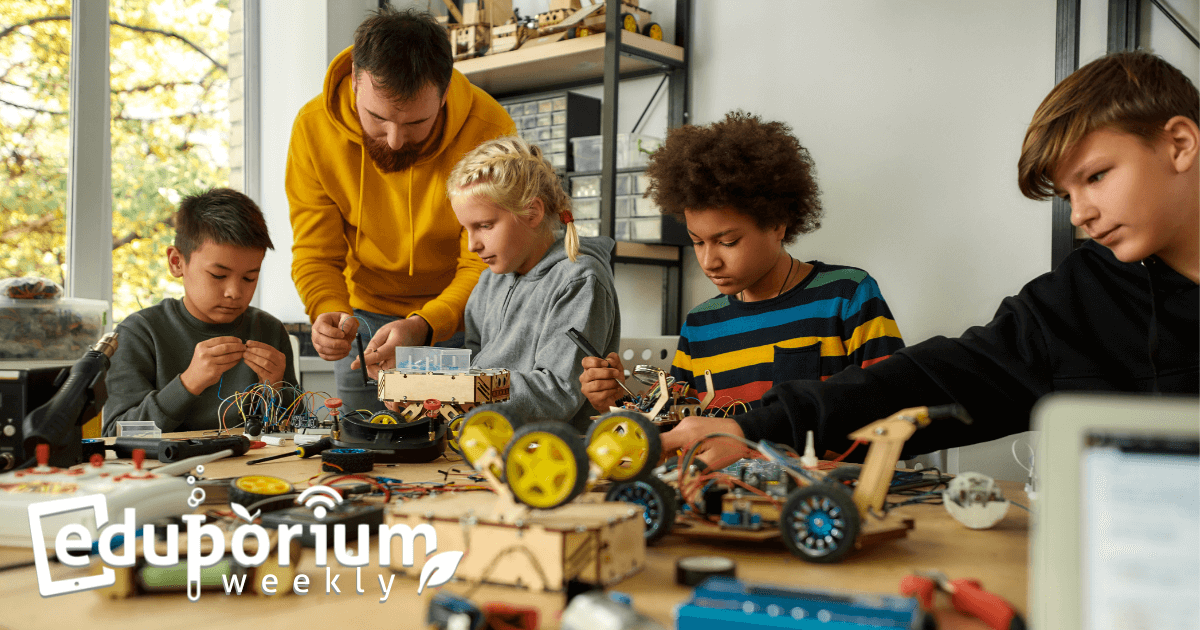If we know one fact about STEM learning, it is that it can happen at any time and in any place. Focusing on STEAM skills and concepts in the classroom is great but there are many more opportunities outside school walls that kids could miss if they are not actively participating. Afterschool STEM programs and summer camp opportunities have been around forever but they're sometimes mainly for child care purposes. Now, we’ve seen shifts in kids wanting to participate in enrichment programs outside the school day to continue developing STEM skills. The best news is that many will jump at these opportunities because they actually enjoy the STEM experiences.
The Impact of Afterschool STEM Learning
There are certain lessons that educators have to cover each day, which sometimes results in less focus on STEM. If a teacher in third grade, for example, wants kids to try robotics or engineering in the classroom, that might come at the expense of spelling or vocabulary lessons, which are obviously also very important. That's why afterschool time is popular for providing these opportunities, which are also key for educational development. Even though grades aren't involved with afterschool programs, these fruitful experiences can still positively impact long-term student development. Afterschool STEM experiences help students build greater interest in STEM education, which boosts engagement and helps them develop STEM skills.
Why afterschool STEM programs are popular.
Research shows that when instructors carefully design STEAM programs, students benefit in the short and long term. In some recent years, we've noticed this impact on students consistently grow from year to year. Since students often associate STEM learning with science classes, exciting them about afterschool STEM also increases excitement for science classes. This, then, could lead to increased engagement, enjoyment, or academic success. Also, kids and their parents now actively seek out afterschool STEAM opportunities, an indication that they're getting what they need. This could be partly because STEAM experiences allow children to learn in different ways—with a greater focus on active inquiry rather than passive lectures.
Gauging success of these programs.
Some indicators of afterschool STEM success include children actively participating in hands-on problem solving and exploration. Further, if these experiences help them become more curious about STEM topics or concepts, that's also a win. Other indicators include students developing the ability to naturally engage in investigative problem solving, the ability to understand the full relevance of STEM for future careers, the awareness of different STEM professions, and understanding the value STEM plays in our society. As kids gain access to more opportunities to participate in STEM learning, they can start developing certain skills. They'll also start to learn more about STEM in general, including all the things we just mentioned. Perhaps as important as the skills they'll learn, this knowledge can help them pursue STEAM in the future thanks to the inspiration they get from STEM opportunities after school.
Tips for Great Afterschool STEM Programs
This case for encouraging students to participate in afterschool STEM programs is now more common and warranted. Not only are teachers pushing to get as many children participating in afterschool STEM as they can, parents are even taking steps to ensure that kids are able to develop these useful skills whenever they can. In creating new afterschool STEAM experiences for students, however, school leaders should strive to give them what they need. This starts with committing to regularity and moving away from the few-and-far-between approach in which kids are only taking part in STEM when educators have time and resources to provide. A consistent and cohesive STEM program is what ensures student STEM experiences matter.
Potential barriers to afterschool STEM programs.
One way to create solid afterschool STEM programs is to research factors that'll typically prevent students from participating in them. First, teachers often don't understand how to create STEM curricula that's both age-appropriate and hands-on. Other factors include limits in time, money, and equipment to give students worthwhile experiences. Next is the lack of educator expertise in teaching STEM skills (or concepts) using today’s educational tools. To combat these challenges, educators can learn about the key STEM concepts students should know, like coding or engineering, for example, then create informal curricula around these ideas. As for funds, you don’t need a whole bunch of equipment in afterschool STEM initiatives. Low-tech and low-cost materials work well for stimulating creativity and a lot of it is even affordable. Finally, a lack of STEM expertise can help students and teachers to begin on the same level and learn together.
Considering the curriculum and teacher training.
Creating great afterschool STEM starts with creating a great plan, which means educators need a bunch of information to design activities and challenges that align with the curriculum. You don't have to reinvent the wheel, however, by creating your own curriculum since there are strong examples to follow. The curriculum could include hands-on activities, inquiry-based learning, and budget-friendly options. More importantly, it should be comfortable for the children and teachers. Also, a great curriculum and cutting-edge equipment won’t amount to much without any well-trained and enthusiastic leaders. Training teachers on using STEM tools should be a fun experience rather than new headaches. And, while preparing, remember to also take some time to evaluate how things are going. If you need to revise some elements, don’t be afraid of taking time to ensure you do things right.

Mistake Making in Afterschool Activities
Afterschool clubs and activities are perfect for kids to experiment and learn freely. With fewer restrictions and pressures, students can try out new problem-solving strategies and embrace mistake-filled learning. In hands-on education, students may try many different approaches to solving a problem before they actually create a solution. This is not unlike the real world and an excellent opportunity for educators to teach them that failure is fine, and they could even celebrate it as long as they fail forward. Afterschool STEAM clubs also help kids collaborate with each other—another skill that is very important for their futures. They might begin to absorb and comprehend information in non-traditional ways when they’re not in their classrooms all day. And, many educators believe that these students greatly benefit from those hands-on, afterschool experiences that help them learn in new ways, especially when they're free from the pressures of failing.
Meeting mistakes with positive reinforcement.
Many students who struggle in the classroom believe they are not smart—something they might carry with them for a while. To help reverse this, educators could use certain language to ensure students understand that they have simply found a way that does not work rather than one that does. Even when they don’t find a solution, positive reinforcement from teachers can help keep their morale high. Though younger students probably don’t realize it, mistakes help their minds grow. If they regularly found easy solutions, they’d stop putting in the effort and have no way of developing their creativity. Mistake making, however, is something everyone can celebrate in afterschool environments and helps students realize the importance of working towards creative solutions and that, once they arrive there, it's very rewarding. Plus, hands-on learning is perfect because kids use their creativity to develop ideas and their persistence while finding solutions.
Sharpening soft skills in afterschool learning.
Making mistakes and revising approaches are huge parts of afterschool STEM and so is collaborating with others. Collaboration is an essential soft skill and active afterschool experiences can help kids learn how to work as a team. It also can help if they have extra eyes to catch any mistakes, and working together to ask questions and solve challenges before they become a problem helps sharpen their inquiry skills. If children see afterschool experiences as creative opportunities, they may become more comfortable with failing. As this happens, they also may become more comfortable with risk taking and exploring new ways of solving problems. As educators, it is important to instill the belief that making mistakes is okay and something we can celebrate. With more freedom to explore without fear, children will gain increased independence while simultaneously building key skills.
Learning a lot with Afterschool Experiences
The fact is that so many students complete high school and then never give STEM another thought. While this, unfortunately, does happen, it's also something educators could potentially prevent by offering STEM experiences and renewing some excitement. Many students will lose interest in STEM because they're not actively participating in it—something that afterschool experiences can help eliminate as children see what STEM has to offer. Opening afterschool STEM clubs to all kids is one way to help ensure that everyone has at least some STEM experiences and takes part in community-based learning. During these meetings, kids can design experiments, explore 21st century problem solving, and work together on custom solutions.
Adding the right technology.
Personally, when we discuss STEAM learning, we'll tend to be more geared towards robotics, engineering, and coding. Of course, there are hundreds of other ways children can participate in STEM, including when using low-tech tools and others that we think of as more traditional. Conducting science experiments with beakers and gases, for example, is still effective for facilitating hands-on problem solving while illustrating the importance of a purposeful approach. If you're looking to add technology to your afterschool STEM, it depends on teacher goals and your ideal learning outcomes. Plus, with the STEM tools you’ll find on our store, students can combine multiple components of STEM learning. This helps educators cover different concepts, like coding, physics, engineering, and architecture to name a few. Kids then learn about things like foundations, slope, angles, program construction, and everything in between with a few simple tools.
Creating a plan for afterschool STEM experiences.
Like with all afterschool clubs, STEM clubs are only as good as the activities that leaders plan. As long as instructors have a plan for meetings, students can often fill the gaps with new discoveries and exploration. Teachers could even scale down and mirror experiments, studies, and challenges professionals do in real-world STEM careers with these students. Naturally, that's a great opportunity for them to get a small taste of the future. Since STEM jobs make up such a large portion of the economy, it could be super important that they get to try STEM challenges from an early age. At the same time, however, it’s important to keep afterschool STEM light and educational so kids want to try more and ultimately develop some new skills.

Afterschool is a Good Time for Robotics and Coding
Whether it’s during school hours or after school, students need STEM and problem solving opportunities to flex their creativity. In many schools, students use makerspaces during the day and as part of afterschool STEM programs to access opportunities for creativity and preparing for their futures. Their goal is simply to prepare students more effectively for an uncertain future—something they won't always get with classroom instruction alone. Plus, with so many options for hands-on, afterschool learning, STEM clubs and programs are popular among both kids and their parents. These opportunities provide deeper, interactive learning for kids, which helps better prepare them for the real world.
Looking to proven programs for inspiration.
Recently, this importance of afterschool activity has spurred teachers to create different clubs to help carry learning into afterschool time. Before STEAM became popular, the focus in many of these clubs was simply on science but, as STEM came on stronger, many shifted to a greater focus on those STEM disciplines, like robotics. With national and international robotics programs and competitions, like FIRST and VEX being so popular, teachers have tried to emulate them in their own afterschool activities when possible. After school, kids could work with simple or advanced robotics kits to build bots, program them, and learn engineering skills. And, with experiences like this, educators can transform traditional playtime into enrichment time.
Designing afterschool programs for kids.
Creating programs like this helps allow all students to experience STEM activities rather than just those in certain situations. Student enjoyment is also typically evident, which helps reinforce how hands-on learning can be fun. Since young students tend to love technology and have grown up around it, they typically jump at a chance to program a robot, for example, and most of them can try this with their own devices at home, too. They also see how technology fluency helps them pick up coding very quickly as robots run programs before their eyes. Whether indoors, outdoors, with a few kids, or in groups, afterschool STEM is something that many kids love. And, at the same time, it's becoming more necessary in preparing them for the future.
For the latest EdTech, STEM, and 21st century education news, follow us on Twitter and Instagram. Like us on Facebook, too, or sign up for our newsletter for our latest product announcements and offerings. If you have an idea for an Eduporium Weekly theme, send us a message on social media or comment below.



